Zoom
Trash

African American History: From Emancipation to the Present. The History of American Slavery. Understanding Slavery - Learning Adventures. Voting Rights: The Court Takes a Page from 1883. Civilrights timeline. Civil Rights Movement Timeline - 1951 to 1959. Race, Prison, and Poverty. The Race To Incarcerate In The Age Of Correctional Keynesianism Paul Street In the last two-and-a-half decades, the prison population has undergone what the United States Bureau of Justice Statistics director Jan Chaiken last year called "literally incredible" expansion.

Chaiken reported a quadrupling of the U.S. incarceration rate since 1975. Race, Riot, and Rebellion: A Bibliography. This morning on the other side of the Atlantic, I woke up early in preparation for a seminar on William Otter, whose History of My Own Times closes the list of our readings in my Revolutionary America class.
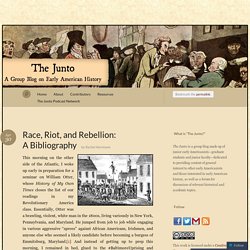
Essentially, Otter was a brawling, violent, white man in the 1800s, living variously in New York, Pennsylvania, and Maryland. He jumped from job to job while engaging in various aggressive “sprees” against African Americans, Irishmen, and anyone else who seemed a likely candidate before becoming a burgess of Emmitsburg, Maryland.[1] And instead of getting up to prep this morning, I remained in bed, glued to the #BaltimoreUprising and #BlackLivesMatter hashtag on Twitter, as, I’m sure, were many of you during the late hours of the night.
During times like these, it’s part of our jobs as historians to acknowledge that different types of violence have specific meanings that change over time. And so Juntoists have compiled a bibliography for our mutual education. A History of Racial Injustice - Equal Justice Initiative. December 31st, 1952 First Year in 70 Years With No Reported Lynchings in the United States On December 31, 1952, for the first time in seventy years, a full year passed with no recorded incidents of lynching.
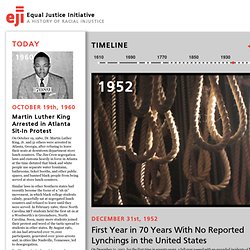
Defined as open, non-judicial murders carried out by mobs, lynching befell people of many backgrounds in the United States but was a frequent tool of racial terror used against black Americans to enforce and maintain white supremacy. Prior to 1881, reliable lynching statistics were not recorded. Civil Rights Movement Timeline (14th Amendment, 1964 Act, Human Rights Law)
Jan. 23 The 24th Amendment abolishes the poll tax, which originally had been instituted in 11 southern states after Reconstruction to make it difficult for poor blacks to vote.
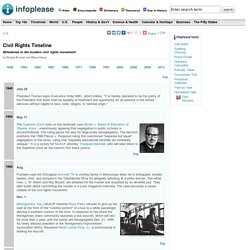
Summer The Council of Federated Organizations (COFO), a network of civil rights groups that includes CORE and SNCC, launches a massive effort to register black voters during what becomes known as the Freedom Summer. It also sends delegates to the Democratic National Convention to protest—and attempt to unseat—the official all-white Mississippi contingent. July 2 President Johnson signs the Civil Rights Act of 1964. Aug. 4. Little rock 9. James Baldwin How to Cool It - James Baldwin 1968 Freddie Gray Riots. Q.
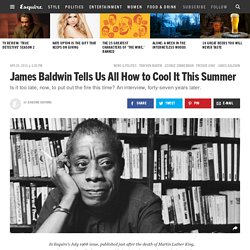
But if industry and government seriously planned job-training programs, and the unions opened up? BALDWIN: Look, the labor movement in this country has always been based precisely on the division of black and white labor. That is no Act of God either. Labor unions along with the bosses created the Negro as a kind of threat to the white worker. There's never been any real kind of threat to the white worker. Q. BALDWIN: Educate their own rank and file. Q. BALDWIN: I'm not sure that you should be asking me these questions at all. Einstein on Race and Racism by Fred Jerome and Rodger Taylor. More than one hundred biographies and monographs of Einstein have been published, yet not one of them mentions the name Paul Robeson, let alone Einstein’s friendship with him, or the name W.

E. B. Du Bois, let alone Einstein’s support for him. Nor does one find in any of these works any reference to the Civil Rights Congress whose campaigns Einstein actively supported. Say It Plain: Great African American Oratory - Download free content from American Public Media. A Lost Story of Segregated America From LIFE's First Black Photographer. Civil Rights (Divided Union) Civil Rights Movement. USA - Civil Rights & Freedoms. Civil Rights.
The Forgotten KIng. Black Power. Injustice at the Intersection. On April 10, 2010, four-year-old A.J.
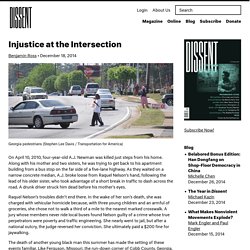
Newman was killed just steps from his home. Along with his mother and two sisters, he was trying to get back to his apartment building from a bus stop on the far side of a five-lane highway. As they waited on a narrow concrete median, A.J. broke loose from Raquel Nelson’s hand, following the lead of his older sister, who took advantage of a short break in traffic to dash across the road.
A drunk driver struck him dead before his mother’s eyes. Raquel Nelson’s troubles didn’t end there. The death of another young black man this summer has made the setting of these events familiar. When created in the middle years of the last century, these were places for middle-class white homeowners to get away from urban poverty. When Michael Brown encountered officer Darren Wilson on August 9, 2014, his suburban environment disadvantaged him triply.
Trayvon Martin Family Interview - Trayvon Martin Aftermath. Baltimore: What Hasn’t Changed by Steven H. Wright. Amid a national epidemic of violence involving police officers and unarmed young black men, the city of Baltimore’s swift prosecution of six police in the alleged murder of Freddie Gray has been seen as a glimmer of hope.
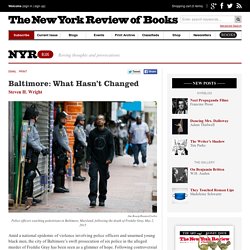
Following controversial grand jury decisions not to indict police in similar cases in Ferguson, Missouri, and New York, as well as a prosecutor’s decision not to pursue charges in Madison, Wisconsin, trust in the criminal justice system among African Americans seemed to have reached new lows. Recent polls suggest as many as 8 in 10 believe that police have different standards based on race; nearly 7 in 10 hold similar beliefs about the courts. By contrast, many have perceived the dramatic decision by Baltimore chief prosecutor Marilyn Mosby to charge six officers in Gray’s death—charges since upheld by a grand jury—as a new resolve to restore faith in the law. Black Lives Matter. #BlackLivesMatter Archives.
The plight of the Black community, in Baltimore and elsewhere, should not overshadow the vibrancy and resilience of Black people.

News reports revealed this week that the leader of a white supremacist group cited by Dylann Roof, the gunmen who killed nine Black people at Emmanuel African Methodist Episcopal Church in Charleston, South Carolina, had donated tens of thousands of dollars to three Republican presidential candidates. This weekend I won’t be enjoying a lazy summer day at home. I’ll be participating in United We Fight with thousands of people to uphold my commitment to this movement for Black lives. Black Lives Matter in South Carolina. Editors’ note: This article is part of a special section on American Movements from our forthcoming summer issue, which went to press before last week’s murder of nine black congregants at Emanuel AME Church in Charleston.
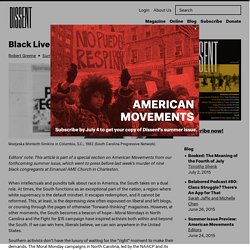
When intellectuals and pundits talk about race in America, the South takes on a dual role. The Past, Present, and Future of the Black Lives Matter Network - Pacific Standard. You won’t see Cathy Hughes or her son Alfred C. Liggins III named in recent headlines about Michael Brown and Ferguson, Missouri. Sherrard Burton, Lee Bailey, and brothers Tuckett and Michael Waite have not been commanding candidates’ attention about how their presidencies will make black lives matter.
The Legacy Of The Charleston Pastor Killed In Last Night's Shooting. Reverend Clementa Pinckney, 41, pastor of the Emanuel African Methodist Episcopal Church in Charleston, South Carolina was among the nine people gunned down in the historic sanctuary Wednesday night allegedly by a young white man who witnesses say spent more than an hour with the congregation in the church before he began shooting.
Pinckney, who had led the church since 2010, has also served in the state legislature since 1997. At 23 years old, he was one of the youngest individuals and the youngest African American to be elected to serve in South Carolina. There, he represented Jasper County, where he grew up and attended public schools. Over his years, he advocated for legislation to reduce violence committed by both civilians and police. Ferguson, Missouri. Components of the Civil Rights Movement.
Black History Resources.